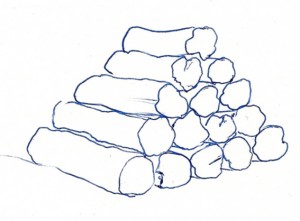Problem Solving: On a separate sheet(s) of paper provide a written response to each of the following questions and bring your written responses to our first class in April 2016. You do not need to post your response on this blog.
Download this assignment [Word document, 3MB] [PDF, 4MB]
Wood Stacking Problem: Hamdi is stacking firewood for her family. The wood is small but each piece is about the same size and shape. Hamdi plans to stack the wood in the format shown below. She estimates there are 100 pieces to stack. Determine if it is possible to stack all 100 pieces of wood all in one pile using this same format.
1(a) Solve the problem showing the details of your work. (3 marks)
1(b) What are the important mathematical ideas or concepts in this problem? (HINT: Consider the Kenyan Mathematics Curriculum). (2 marks)
1(c) Which of the following problem solving strategies did you use (2 marks):
- Working backwards
- Finding a pattern
- Adopting a different point of view
- Solving a simpler analogous problem
- Considering extreme cases
- Making a drawing
- Guess and test
- Accounting for all possibilities
- Organizing data
- Logical Reasoning
1(d) Provide two reasons why this math problem is a good problem for your students. What mathematics do students need to know in order to solve this problem? Explain.
(4 marks)
1(e) Provide an adaption to the problem that extends the problem to meet the needs of students who require more of a challenge. Explain your adaption. (5 marks)
1(f) Provide an adaption to the problem that makes the problem more accessible to students who may find it difficult to solve. Explain your adaption (5 marks)
1(g) Create two different mathematics problems to introduce to your students that build on the important mathematical concepts in the Wood Staking problem above. Discuss how your math problems build on the mathematical concepts/ideas found in the Wood Stacking Problem. (10 marks)

